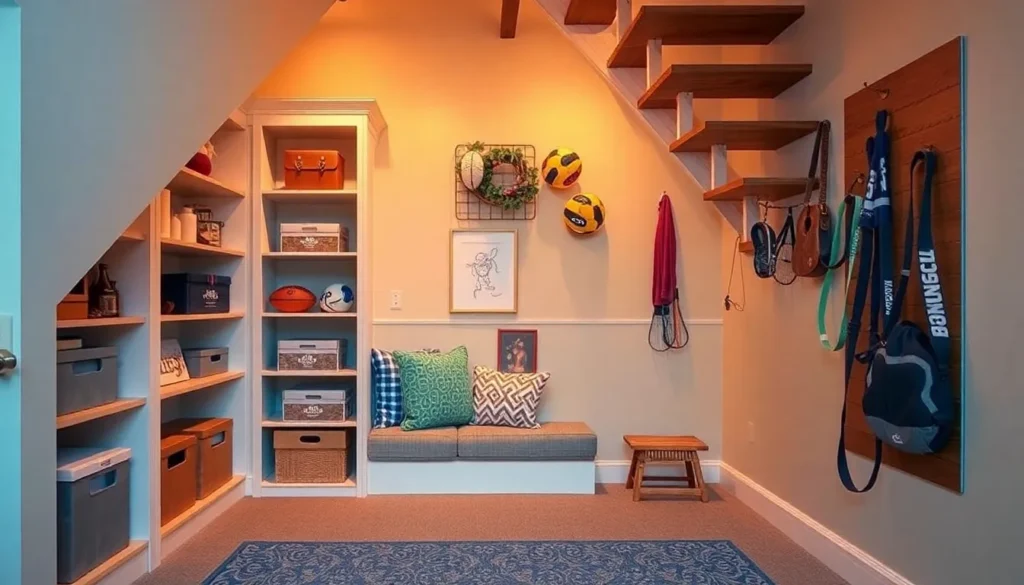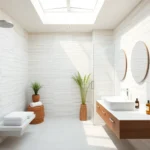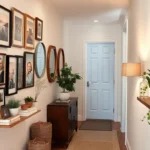That awkward space beneath your staircase doesn’t have to remain a dusty catch-all for forgotten items. We’ve all walked past that under-stair area countless times, wondering how to transform it into something functional and beautiful. The truth is, this often-overlooked space holds incredible potential for creative storage answers that’ll revolutionize your home organization.
Whether you’re dealing with a cramped apartment or a spacious house, under-stair storage can solve multiple organizational challenges while adding real value to your property. From sleek built-in shelving to clever closet conversions, we’ll show you how to maximize every square inch of this valuable real estate.
You’ll discover practical ideas that work for any budget and skill level, transforming your wasted space into a storage powerhouse that’ll make your neighbors envious. Let’s unlock the hidden potential lurking beneath your stairs and create storage answers that actually work for your lifestyle.
Transform Your Under-Stairs Space Into a Functional Storage Haven
We’ll guide you through the essential steps to maximize your under stairs storage potential and create an organized sanctuary that works for your lifestyle.
Assess your space dimensions and structural elements to understand what storage answers will fit properly. Measure the height, width, and depth at multiple points since staircase angles create varying dimensions throughout the area. Check for electrical wiring, plumbing, or HVAC components that might limit your design options.
Determine your primary storage needs by cataloging items you want to organize in this space. Consider seasonal decorations, cleaning supplies, shoes, coats, or hobby materials that currently lack proper storage. Match your inventory to the available space to prioritize which items deserve premium real estate.
Plan your access strategy based on how frequently you’ll retrieve stored items. Design pull out drawers for daily essentials like shoes or cleaning products. Reserve higher shelves or deeper recesses for seasonal items you access only a few times per year.
Choose appropriate storage systems that complement your home’s architecture and your organizational style. Built in shelving maximizes every inch of available space while maintaining a custom appearance. Modular storage units offer flexibility and can adapt as your needs change over time.
Install proper lighting to make your under stairs storage both functional and safe. LED strip lights provide even illumination without generating heat in confined spaces. Motion activated switches ensure you can always see what you’re looking for without fumbling for controls.
Create designated zones for different categories of items to maintain long term organization. Establish exact areas for cleaning supplies, seasonal gear, and everyday essentials. Label each zone clearly so family members can easily maintain the system you’ve created.
Create a Custom Built-In Closet for Maximum Organization
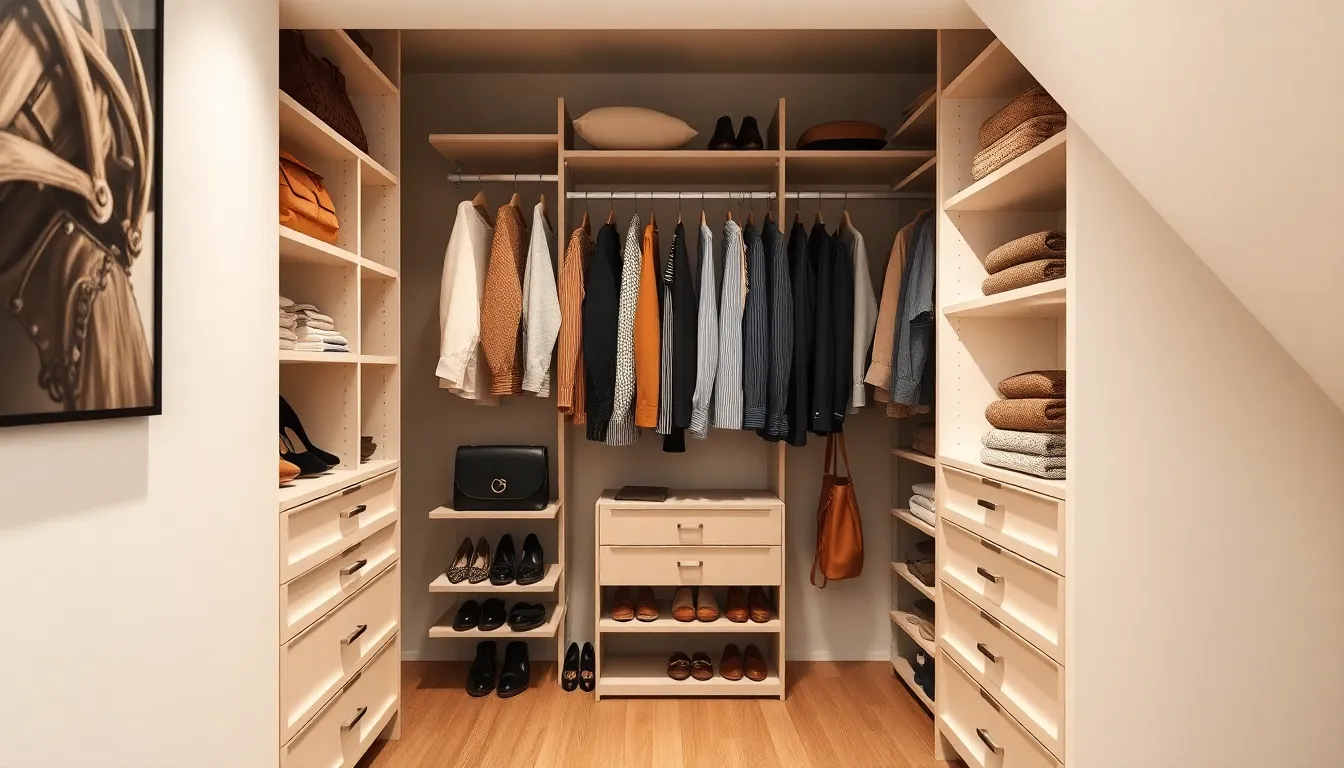
Building a custom closet under your stairs transforms the awkward triangular space into a highly efficient storage solution. We can design this closet to fit the unique shape perfectly, maximizing every inch of available space.
Install Adjustable Shelving Systems
Flexibility becomes your greatest asset when installing adjustable shelving systems in your under stairs closet. We recommend using track and bracket systems that allow you to move shelves up or down as your storage needs change.
Position shelves at varying heights to accommodate different items like sweaters, blankets, or storage boxes. Taller items such as vacuum cleaners or sports equipment fit perfectly in the higher sections where the ceiling slopes upward. Lower shelves work excellently for frequently accessed items like shoes, bags, or daily essentials.
Consider installing shelves with different depths throughout the space. Deeper shelves near the back wall hold bulky items, while shallower shelves near the front provide easy access to smaller belongings.
Add Hanging Rods for Clothing Storage
Strategic placement of hanging rods maximizes your clothing storage capacity within the sloped ceiling constraints. We suggest installing rods at different heights to create zones for various garment lengths.
Mount a higher rod near the tallest section for long coats, dresses, or suits that need full hanging space. Position a lower rod in the middle area for shirts, blouses, or children’s clothing that require less vertical clearance.
Double hanging rods work exceptionally well in areas with sufficient height, effectively doubling your hanging storage. Install the upper rod for shorter items like shirts while reserving the lower rod for pants or skirts.
Include Drawer Units for Small Items
Built in drawer units provide organized storage for small items that often create clutter in other areas. We can install these units at the base of your closet or integrate them into the side walls for maximum space efficiency.
Shallow drawers work perfectly for jewelry, socks, ties, or belts, keeping these items separated and easily accessible. Deeper drawers accommodate bulkier items like sweaters, linens, or seasonal accessories.
Consider adding dividers within drawers to create compartments for different categories of items. Soft close drawer slides ensure smooth operation and prevent slamming that could damage stored items or disturb household members.
Design a Home Office Nook With Smart Storage Solutions
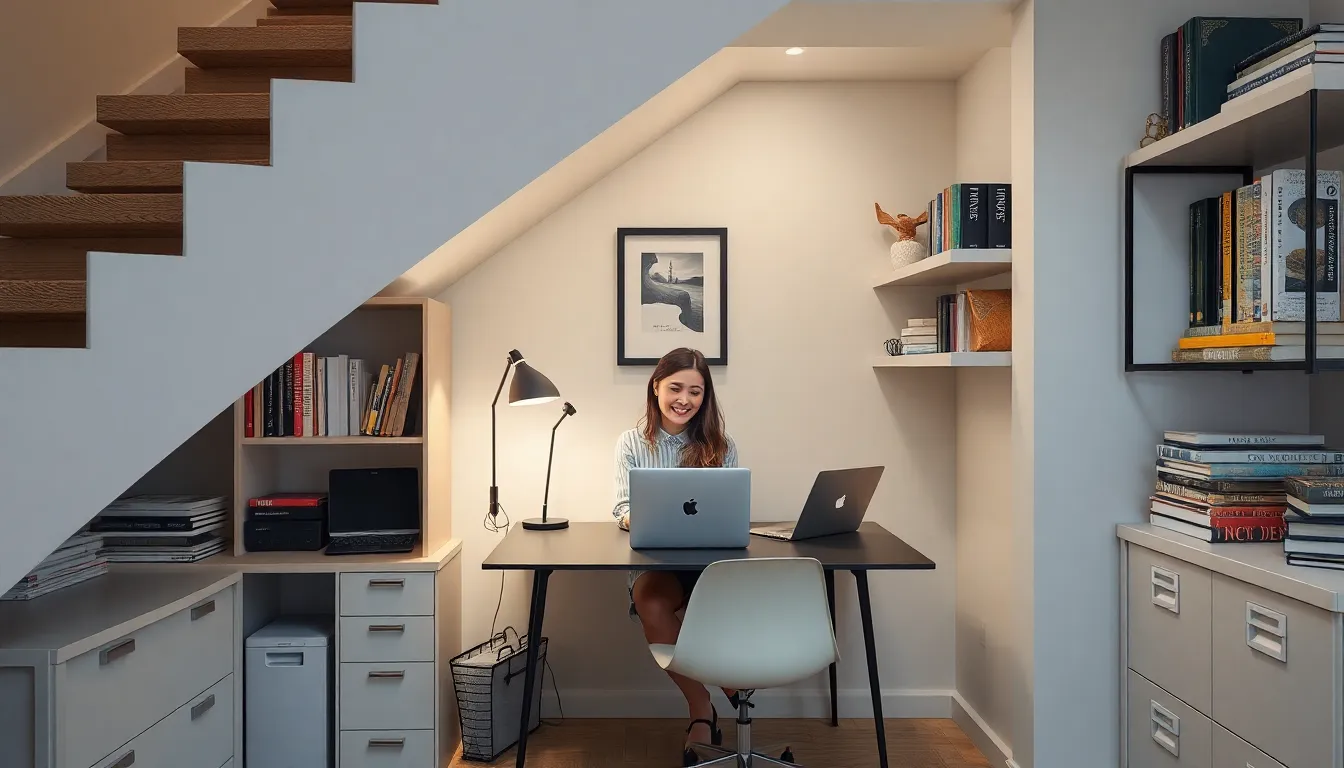
Transform your under stair space into a productive workspace that combines functionality with clever storage answers. We’ll show you how to create an efficient home office that maximizes every inch of this unique area.
Build a Compact Desk With Hidden Compartments
Custom desks built into the stair void offer retractable surfaces that save space when not in use. We recommend installing drop down panels or fold out work surfaces that can be tucked away completely when your workday ends. These space saving designs accommodate laptops, documents, and essential office supplies while maintaining a clean appearance.
Hidden compartments beneath the desk provide secure storage for tech devices and personal items. Install hinged panels with magnetic closures for seamless access to charging cables, hard drives, tablets, or sensitive documents. We suggest incorporating shallow drawers for stationery items like pens, paperclips, and business cards. Deep compartments work well for storing larger equipment such as printers, scanners, or backup drives.
Ergonomic planning ensures comfortable use even though the unique space constraints. Position the desk surface at standard height (28 to 30 inches) and include adequate legroom underneath. We recommend adding proper lighting fixtures and electrical outlets within easy reach to support computer equipment and task lighting needs.
Install Wall-Mounted Shelves for Supplies
Wall mounted shelves along the stair wall maximize vertical storage without consuming floor space. We suggest installing floating shelves at varying heights to accommodate different sized items while working within the sloped ceiling limitations. These shelves can hold reference books, binders, office equipment, and decorative elements that personalize your workspace.
Adjustable shelving systems provide flexibility for changing storage requirements. Install track mounted brackets that allow you to reposition shelves as your needs evolve. We recommend spacing shelves 12 to 18 inches apart for standard office supplies and books. Consider deeper shelves (8 to 10 inches) for larger items like three ring binders or small office machines.
Strategic placement keeps frequently used items within arm’s reach of your desk area. Position everyday supplies like staplers, tape dispensers, and reference materials on lower shelves for easy access. We suggest using upper shelves for archive materials, seasonal items, or decorative storage boxes that aren’t accessed daily.
Create Filing Storage for Important Documents
Rolling file cabinets maximize document storage while maintaining mobility within the compact space. We recommend choosing units with locking mechanisms to protect sensitive paperwork and confidential information. These cabinets can slide under your desk when not in use or move to different positions as needed for various tasks.
Vertical hanging folder systems organize paperwork efficiently in minimal floor space. Install wall mounted file holders or use tall, narrow filing cabinets that fit the triangular under stair dimensions. We suggest using color coded folders for different categories like taxes, insurance, warranties, and household documents to streamline retrieval.
Lockable drawer systems provide secure storage for important documents and personal information. Choose filing answers with multiple drawer sizes to accommodate letter sized documents, legal papers, and smaller items like business cards or receipts. We recommend positioning these drawers at comfortable heights for easy access while seated at your workspace.
Build a Pantry Paradise for Kitchen Overflow
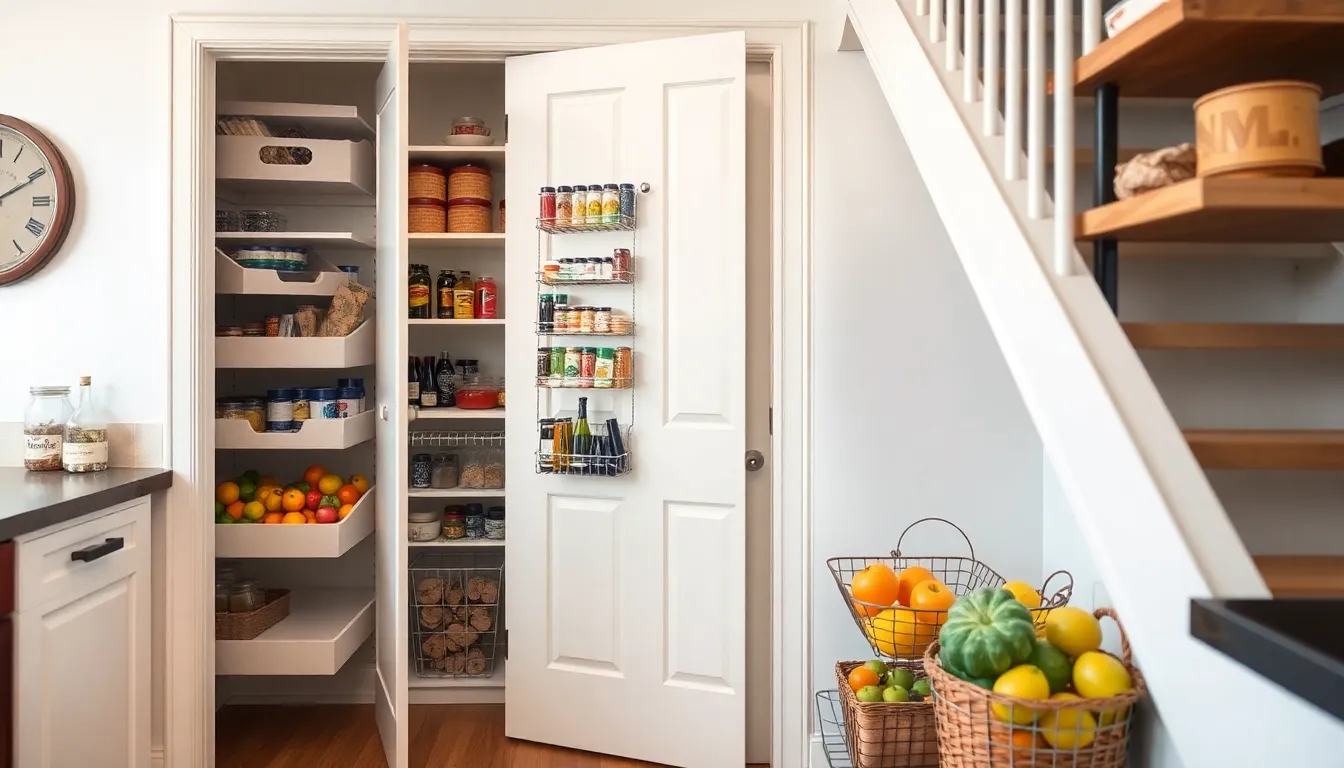
We’ve discovered that transforming your under stair space into a dedicated pantry creates exceptional overflow storage for your kitchen essentials. Research shows this setup effectively frees up main kitchen storage while keeping food items organized and easily accessible.
Install Pull Out Drawers for Easy Access
Pull out drawers revolutionize how we use the awkward triangular space beneath stairs. Custom sliding drawers can be customized to fit the unique shape of your under stair area, providing seamless storage for kitchen tools, small appliances, and pantry items.
Touch release mechanisms eliminate the need for handles or knobs, creating a sleek appearance while maintaining effortless access to stored items. We recommend installing drawers at varying depths to accommodate different sized kitchen essentials, from spice jars to larger cooking equipment.
Sliding drawer systems maximize every inch of available space by extending fully, allowing you to reach items stored in the deepest corners. This configuration keeps clutter hidden while providing complete visibility of stored contents when drawers are extended.
Add Wire Baskets for Produce Storage
Wire baskets offer ideal storage answers for fresh produce and bulk pantry items in your under stair pantry. These ventilated containers promote proper air circulation around fruits and vegetables, helping extend their freshness and reduce food waste.
Pullout wire baskets can be mounted on sliding tracks, making it easy to access items stored in deeper areas of your pantry space. We suggest organizing baskets by produce type, with separate containers for root vegetables, citrus fruits, and leafy greens.
Stackable wire basket systems allow you to maximize vertical space while maintaining visibility of stored items at a peek. This organization method helps you quickly identify what you have on hand and prevents duplicate purchases during grocery shopping trips.
Create Spice Racks on Door Panels
Spice racks mounted on the interior of pantry doors optimize vertical storage without consuming valuable shelf space. Installing magnetic panels or mounted racks on door surfaces keeps spices and small kitchen essentials organized and easily accessible.
We recommend using adjustable door mounted racks that can accommodate various jar sizes, from standard spice containers to larger seasoning bottles. This setup works particularly well for compact kitchen layouts where counter and cabinet space is limited.
Magnetic spice storage systems allow you to customize your organization based on cooking frequency, placing most used spices at eye level for quick access. Clear labeling on spice containers ensures you can identify ingredients quickly while cooking, streamlining your meal preparation process.
Construct a Stylish Wine Cellar and Bar Area

We can transform our under-stairs space into an elegant wine cellar and entertaining area that rivals professional installations. This sophisticated storage solution maximizes our unused space while creating a stunning focal point for our home.
Design Temperature-Controlled Wine Storage
Creating proper climate conditions protects our wine investment and ensures optimal aging. We need to maintain temperatures between 55°F and 57°F with humidity levels around 60% for ideal wine preservation.
Installing a dedicated climate control system keeps our collection in perfect condition year-round. Small-scale cooling units designed for compact spaces fit seamlessly under stairs without major renovations.
Selecting the right storage style enhances both function and aesthetics. Minimalist designs feature sleek metal or glass shelving that creates clean lines and modern appeal. Rustic approaches incorporate wooden wine racks with natural stone accents for cozy warmth. Modern styles combine metal frames with glass displays and LED accent lighting for contemporary sophistication.
Positioning wine bottles horizontally keeps corks moist and prevents oxidation. Angled storage racks showcase our collection while maximizing bottle capacity in the triangular space.
Add Glass Display Shelves for Glassware
Installing glass shelves creates an elegant display area for our stemware and bar accessories. These transparent surfaces maintain visual lightness while providing sturdy support for delicate glassware.
Implementing strategic lighting transforms our display into a stunning showcase. Spot lights positioned beneath each shelf illuminate our glasses from below, creating dramatic shadows and highlighting crystal patterns.
Arranging glassware by type and frequency of use optimizes both beauty and functionality. We can dedicate upper shelves for special occasion pieces and lower areas for everyday wine glasses.
Securing shelves properly prevents accidents and protects our investment. Tempered glass shelving with proper mounting hardware supports important weight while maintaining safety standards.
Include a Mini Refrigerator Compartment
Integrating a compact refrigerator provides convenient storage for chilled beverages and bar essentials. Wine-exact coolers maintain different temperature zones for whites, reds, and champagne.
Selecting an under-counter model preserves our design aesthetic while maximizing functionality. Built-in units blend seamlessly with surrounding cabinetry and eliminate visual disruption.
Positioning the refrigerator at counter height creates an efficient bartending workspace. This placement reduces bending and provides easy access during entertaining.
Adding complementary storage around the refrigerator unit creates a complete bar setup. Built-in cabinets house mixers, garnishes, and bar tools within arm’s reach of our chilled beverages.
Establish a Cleaning Supply Command Center
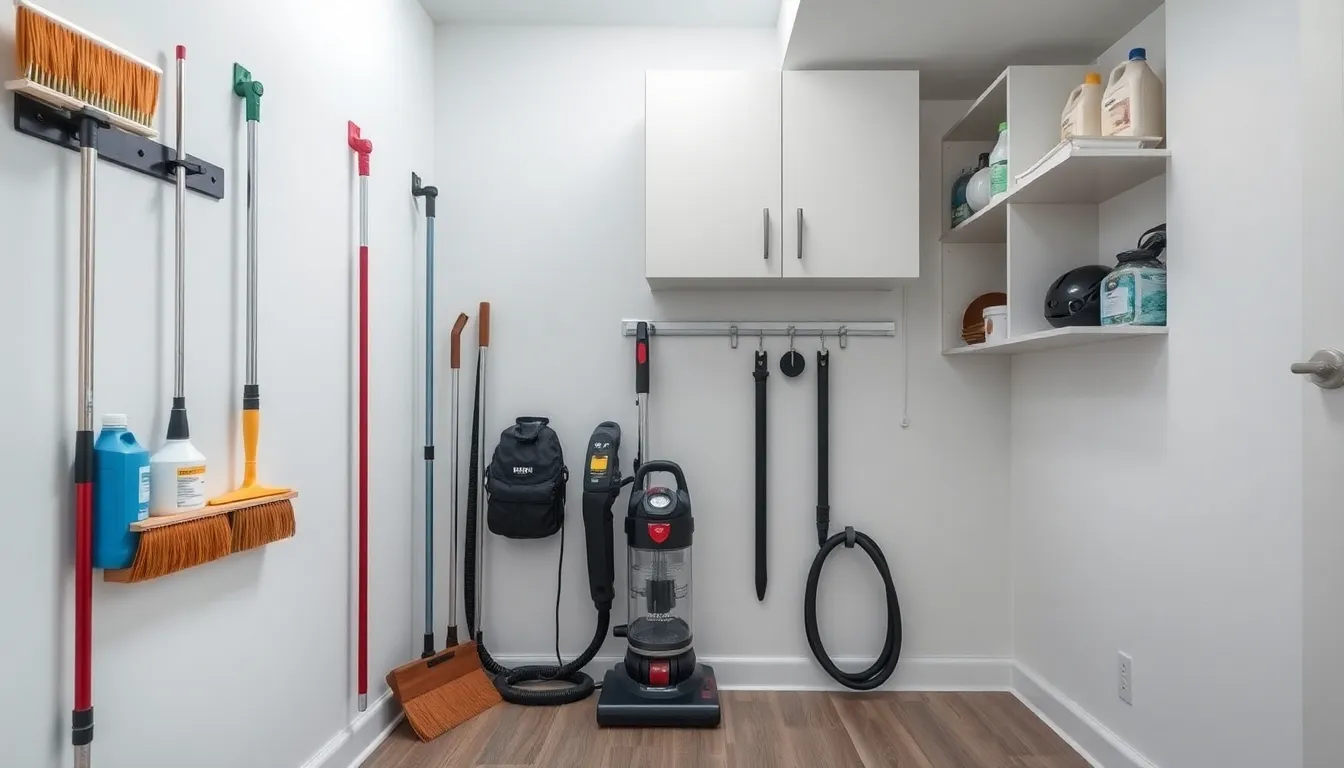
We can transform the under-stairs area into a centralized hub that keeps all our cleaning supplies organized and easily accessible. This dedicated space eliminates the need to search through multiple cabinets and creates an efficient system for maintaining our home.
Install Broom and Mop Holders
Wall-mounted holders keep long-handled cleaning tools upright and prevent them from falling over or cluttering floor space. We should position these holders on the tallest wall of the under-stairs area to accommodate full-length brooms and mops without bending the handles.
Spring-loaded clips work exceptionally well for securing handles of various thicknesses including traditional brooms, microfiber mops, and extendable dusters. Installing these clips at different heights allows us to store multiple tools while keeping them separated and easy to grab.
Magnetic strips offer another mounting solution for metal-handled tools and can hold smaller cleaning implements like dustpans or scrub brushes. We can attach these strips to the side walls or ceiling supports for additional vertical storage options.
Create Chemical Storage With Safety Locks
Lockable cabinets provide essential security for storing household cleaners away from children and pets while maintaining easy adult access. We should install these cabinets in the lower portion of the under-stairs space where the ceiling height naturally creates enclosed storage areas.
Safety latches on cabinet doors add extra protection and come in various styles including magnetic locks, sliding locks, and cabinet handle locks. These mechanisms ensure that even if we forget to lock the main cabinet our cleaning chemicals remain secure.
Ventilation considerations become crucial when storing chemical cleaners in enclosed spaces to prevent fume buildup. We can install small battery-operated fans or ensure gaps around cabinet doors to maintain proper air circulation.
Segregated storage zones help us organize different types of cleaners including separating acidic cleaners from bleach products to prevent dangerous chemical reactions. We should use separate containers or cabinet sections for different cleaner categories.
Add Vacuum Cleaner Storage Space
Dedicated alcoves can be built into the under-stairs design to perfectly fit standard upright or canister vacuum cleaners. We should measure our vacuum dimensions before construction to ensure the space accommodates both the main unit and all attachments.
Electrical outlets positioned within the vacuum storage area allow us to keep the unit plugged in and ready for immediate use. Installing a dedicated outlet eliminates the need to find available plugs throughout the house when we need to clean.
Attachment storage systems keep vacuum accessories organized using wall-mounted brackets, pegboards, or small shelves built into the vacuum alcove. We can label each storage spot to maintain organization and quickly locate exact attachments.
Cord management answers prevent tangled vacuum cords through built-in hooks or cord wraps that keep electrical cables neat and protected. These systems extend the life of our vacuum cleaner by preventing cord damage from improper storage.
Develop a Kids’ Toy Storage Wonderland

Converting your under stairs space into a dedicated children’s storage area transforms chaos into organized bliss while keeping toys accessible yet out of sight.
Build Low-Height Cubbies for Easy Access
Low height cubbies encourage independence by allowing children to reach their belongings without assistance. We recommend positioning these storage compartments between 18 to 30 inches from the floor for optimal accessibility across different age groups.
Design considerations include using rounded corners and smooth finishes to prevent injuries during play. Each cubby should measure approximately 12 inches deep and 15 inches wide to accommodate most toys like building blocks, stuffed animals, and board games.
Labeling systems transform organization into a fun learning activity for kids. We suggest using picture labels combined with words to help young children identify storage locations while developing reading skills.
Safety features matter significantly in children’s storage areas. Installing soft close hinges prevents pinched fingers, while using non toxic materials ensures a healthy play environment.
Install Pull-Out Toy Bins
Pull out bins maximize the awkward triangular space under stairs while providing complete access to stored items. These sliding storage answers work particularly well for bulky toys like sports equipment, musical instruments, and large building sets.
Soft close slides prevent slamming and protect little fingers from getting caught. We recommend heavy duty slides rated for at least 75 pounds to handle the weight of multiple toys and withstand frequent use.
Bin materials should prioritize durability and easy cleaning. Plastic bins resist moisture and clean easily with soap and water, while fabric bins offer softer edges and come in colorful patterns that appeal to children.
Organization strategies include using clear bins for frequently accessed toys and opaque bins for seasonal items. We suggest installing bins at varying heights to accommodate different toy sizes and children’s growth stages.
Create a Reading Nook With Book Storage
Reading nooks transform dead space into cozy learning environments that encourage literacy habits. We recommend installing comfortable seating like built in benches with cushioned tops to create an inviting atmosphere.
Book storage answers include floating shelves positioned at child friendly heights and angled display ledges that showcase book covers. Installing shelves between 24 to 36 inches high ensures easy access while preventing books from becoming floor clutter.
Lighting considerations enhance the reading experience and protect developing eyesight. We suggest installing LED strip lights under shelves or battery operated sconces to provide adequate illumination without complex electrical work.
Comfort elements like soft pillows, cozy blankets, and small side tables for snacks create an irresistible reading retreat. Adding a small basket for current favorites keeps the most loved books within arm’s reach while maintaining organization.
Set Up a Sports Equipment Storage System

Sports equipment storage under stairs transforms chaotic gear piles into organized systems that keep your active lifestyle accessories easily accessible. Custom cabinetry answers can accommodate everything from bicycles to hockey sticks while maximizing every inch of available space.
Design Vertical Bike Storage Racks
Vertical bike storage racks maximize floor space by utilizing wall height in your under stairs area. We recommend mounting these racks directly to wall studs for maximum stability when storing multiple bikes efficiently.
Wall mounted systems work best when positioned at varying heights to accommodate different bike sizes. Custom cabinetry can integrate vertical storage seamlessly with your existing decor while providing dedicated spaces for each bicycle.
Floor to ceiling designs allow you to store bikes without consuming valuable walking space. Installing these racks requires measuring your ceiling height and bike dimensions to ensure proper clearance for easy removal.
Professional installation ensures your vertical storage system can handle the weight of multiple bikes safely. We suggest adding protective padding where bikes contact the wall to prevent scratches on both surfaces.
Add Hooks for Sporting Goods
Hooks provide versatile storage answers for various sporting goods that don’t require specialized mounting systems. Strong wall hooks can support bags, gloves, and lightweight equipment like skateboards without complex installation procedures.
Heavy duty options work well for bulkier items that need secure mounting points. We position hooks at different heights to accommodate family members of varying sizes and equipment types.
Strategic placement keeps frequently used items within easy reach while storing seasonal gear higher up. Installing hooks near the entrance of your under stairs storage makes grabbing equipment quick and convenient.
Multiple hook styles serve different purposes, from single prong designs for bags to multi prong versions for organizing smaller accessories. We recommend using hooks rated for at least twice the weight of items you’ll hang.
Create Seasonal Equipment Rotation Areas
Seasonal equipment rotation areas help you organize gear based on current activity schedules and weather conditions. Movable shelves allow easy reconfiguration when switching between summer and winter sports equipment.
Designated zones separate warm weather gear from cold weather essentials using clearly marked storage sections. We suggest using bins or drawers that slide out completely for easy access to off season items.
Rotation systems work best when you can quickly identify and swap equipment without disrupting your entire storage setup. Creating inventory lists helps track which items are stored in each seasonal section.
Accessible placement ensures you can reach rotation areas without removing other equipment first. We recommend positioning seasonal storage at medium heights where items stay visible but don’t interfere with daily access needs.
Establish a Mudroom Entry With Boot Storage

We’ll transform your under-stairs space into an efficient mudroom that manages the daily chaos of family life. Creating a designated entry area prevents dirt and clutter from spreading throughout your home.
Install Individual Cubbies for Each Family Member
Designating exact cubbies for each family member creates personal responsibility and prevents items from getting mixed up. We recommend building cubbies at different heights to accommodate family members of various ages, with lower sections for children and higher compartments for adults. Each cubby should measure approximately 12 inches wide by 15 inches deep to accommodate shoes, bags, and personal accessories.
Personalizing each cubby with name labels or family photos helps everyone identify their designated space quickly. Built-in compartments work exceptionally well in the triangular under-stairs area since we can customize the dimensions to fit the sloped ceiling perfectly. Consider adding small baskets or dividers within each cubby to separate different types of items like scarves, gloves, and sunglasses.
Add Shoe Racks and Boot Trays
Installing shoe racks prevents footwear from creating messy piles on the floor while keeping your entry area organized. We suggest using pull-out shoe racks that maximize storage capacity in the narrow under-stairs space, allowing easy access to footwear stored in the back. Adjustable shelving systems work particularly well since they can accommodate different shoe heights from sneakers to tall boots.
Boot trays positioned at the bottom of each cubby protect flooring from water damage and salt stains during wet weather. Removable trays make cleaning simple and prevent moisture from accumulating in your storage area. Choose trays with raised edges and drainage holes to contain water effectively while allowing proper air circulation for faster drying.
Include Hooks for Coats and Bags
Strategic hook placement transforms vertical wall space into valuable storage real estate for frequently used outerwear and accessories. We recommend installing hooks at varying heights to accommodate different family members, with sturdy hooks positioned at adult eye level and smaller hooks placed lower for children’s jackets and backpacks.
Double hooks maximize storage capacity without requiring additional wall space, allowing each family member to hang both a coat and a bag in their designated area. Consider using fold-down hooks that lie flat against the wall when not in use, preventing head bumps in the confined under-stairs space. Heavy-duty wall anchors ensure hooks can support winter coats and loaded backpacks without pulling away from the wall.
Create a Pet Care Station With Supply Storage
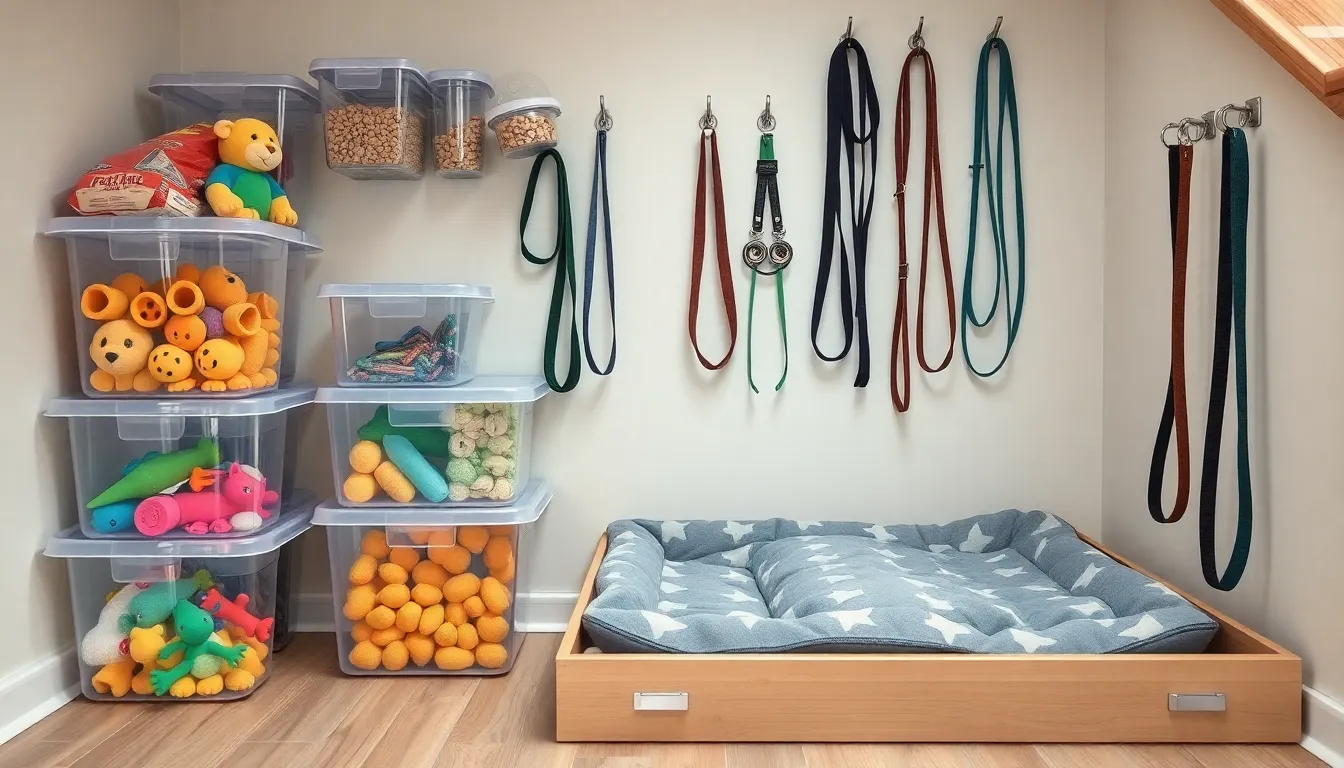
Transforming your under-stairs space into a dedicated pet care station keeps all your furry friend’s essentials organized and easily accessible. This centralized approach eliminates the frustration of searching for pet supplies throughout your home while creating a functional storage hub.
Build Food and Treat Storage Containers
Airtight containers preserve pet food freshness while maximizing your under-stairs storage capacity. We recommend installing sliding drawers or pull-out bins that use the triangular space efficiently, keeping daily meals separate from other household items. Plastic bins and baskets work perfectly for organizing different types of treats, allowing you to categorize by flavor or size for quick selection during training sessions.
Custom shelving accommodates various container sizes, from large kibble storage to smaller treat dispensers. Position frequently used items at eye level for convenient access, while storing bulk supplies in deeper areas of the space. Label each container clearly to maintain organization and prevent mix-ups between different pet foods or dietary requirements.
Add Leash and Toy Organization
Wall-mounted hooks and pegs transform chaotic pet accessories into an orderly system that streamlines daily walks and playtime. Install these storage answers on interior cabinet doors or directly on the wall to hang leashes, collars, and harnesses without consuming valuable shelf space. Spring-loaded clips work exceptionally well for retractable leashes and training equipment.
Designated bins and baskets keep toys sorted by type, size, or pet preference, making cleanup effortless after play sessions. We suggest using clear containers for frequently accessed toys, allowing pets to see their favorites while maintaining tidiness. Wire baskets promote air circulation for outdoor toys that might retain moisture, preventing odors and extending toy lifespan.
Include Pet Bed Storage Answers
Foldable pet beds store efficiently in shallow drawers beneath the stairs, maximizing space utilization during seasons when they’re not needed. Built-in storage ottomans serve double duty by providing a cozy resting spot while concealing extra bedding, blankets, or seasonal pet accessories underneath. This approach keeps comfort items clean and readily available for rotation.
Consider creating a permanent pet nook within the under-stairs area if space permits, integrating storage compartments directly beneath a built-in sleeping area. Position this cozy retreat away from high-traffic zones to ensure your pets feel secure while maintaining easy access to their stored belongings. Cushioned surfaces can be customized to fit the triangular space perfectly, creating a comfortable haven that doesn’t compromise your storage goals.
Conclusion
We’ve explored countless ways to transform your under-stairs area from a forgotten corner into a highly functional storage powerhouse. Whether you’re creating a home office nook or organizing sports equipment these answers can dramatically improve your home’s efficiency and value.
The key lies in understanding your exact needs and choosing storage systems that work with your space’s unique dimensions. From built-in closets to pet care stations each option we’ve discussed offers practical benefits that extend far beyond simple storage.
Your under-stairs space doesn’t have to remain unused. With proper planning and the right approach you can create an organized solution that perfectly fits your lifestyle while maximizing every square inch of available space.
Frequently Asked Questions
What are the first steps to planning under-stairs storage?
Start by measuring the space dimensions and identifying structural elements like support beams or plumbing. Catalog items you need to store to determine your primary storage needs. Plan your access strategy based on how frequently you’ll retrieve items, and choose storage systems that complement your home’s architecture.
Can I create a home office under the stairs?
Yes, the under-stairs space can be transformed into a productive home office nook. The triangular area provides enough room for a compact desk setup, and you can add built-in shelving for office supplies and documents while maintaining functionality in the awkward space.
What’s the best way to store cleaning supplies under stairs?
Install wall-mounted holders for brooms and mops using spring-loaded clips or magnetic strips. Use lockable cabinets for household cleaners with proper ventilation, and create dedicated alcoves for vacuum storage with electrical outlets and cord management systems for easy access and safety.
How can I make under-stairs storage safe for kids?
Design low-height cubbies for easy access and use pull-out bins for bulky toys. Install safety features like rounded corners and secure latches. Use clear bins for frequently accessed items and create designated zones with proper labeling to help children maintain organization independently.
Is it possible to create a wine storage area under stairs?
Absolutely! You can construct a stylish wine cellar with temperature-controlled storage using small-scale cooling units. Position bottles horizontally to prevent oxidation, add glass display shelves for stemware, and include strategic lighting to showcase your collection while maximizing the triangular space.
What lighting should I use for under-stairs storage?
Install LED strip lights or battery-operated motion sensor lights for functionality and safety. Consider task lighting for specific areas like reading nooks or work spaces. Proper lighting is essential for accessing stored items safely and showcasing display areas effectively.
How do I organize sports equipment under the stairs?
Create custom cabinetry with vertical bike storage racks to maximize floor space. Install hooks for various sporting goods and establish seasonal equipment rotation areas. Use the triangular space efficiently by accommodating different equipment sizes with adjustable storage solutions.
Can I create a pantry under the stairs?
Yes, build pull-out drawers to maximize the triangular space for kitchen tools and pantry items. Install wire baskets for fresh produce to promote air circulation, and create spice racks on door panels to optimize vertical storage without consuming valuable shelf space.

